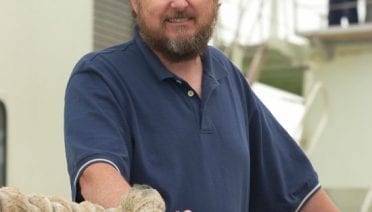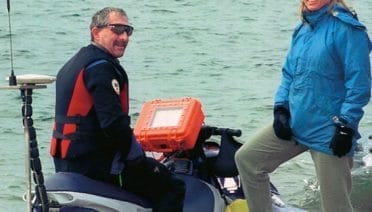Press Room
A Cooperative Agreement signed today by the National Science Foundation (NSF) and the Consortium for Ocean Leadership (OL) gives Woods Hole Oceanographic Institution (WHOI) and its partners approval to begin construction on ocean observing infrastructure at coastal sites offshore of…
A new 2,000-year-long reconstruction of sea surface temperatures (SST) from the Indo-Pacific warm pool (IPWP) suggests that temperatures in the region may have been as warm during the Medieval Warm Period as they are today. The IPWP is the largest…
The Woods Hole Oceanographic Institution (WHOI) announced today that it has appointed Christopher J. (Chris) Winslow to the position of chief financial officer (CFO) and VP for Finance and Administration. Winslow will assume his duties at WHOI on August 24,…
Changes in ocean chemistry — a consequence of increased carbon dioxide (CO2) emissions from human industrial activity — could cause U.S. shellfish revenues to drop significantly in the next 50 years, according to a new study by researchers at the…
A new type of deep-sea robotic vehicle called Nereus has successfully reached the deepest part of the world’s ocean, reports a team of U.S. engineers and scientists aboard the research vessel Kilo Moana. The dive to 10,902 meters (6.8 miles)…
The most extensive study of pollutants in marine mammals’ brains reveals that these animals are exposed to a hazardous cocktail of pesticides such as DDTs and PCBs, as well as emerging contaminants such as brominated flame retardants. Eric Montie, the…
Forecasts of polar bear populations and their likely responses to climate change have been strengthened by a new publication that refutes criticisms of the scientific basis for listing the polar bear under the Endangered Species Act. The new paper, by…
Oceanographers have long known that the 20-year-old paradigm for describing the global ocean circulation– called the Great Ocean Conveyor – was an oversimplification. It’s a useful depiction, but it’s like describing Beethoven’s Fifth Symphony as a catchy tune. The ocean…
A new study by researchers at Woods Hole Oceanographic Institution (WHOI) and the University of California, Santa Barbara (UCSB) is the first to quantify the amount of oil residue in seafloor sediments that result from natural petroleum seeps off Santa…
On Monday, May 4, a team of researchers from the Woods Hole Oceanographic Institution (WHOI) was working in the Great South Channel 40 miles east-southeast of Chatham, Mass., when they sighted a humpback whale severely entangled in fishing gear. They…
The potential for an outbreak of the phenomenon commonly called “red tide” is expected to be “moderately large” this spring and summer, according to researchers with the Woods Hole Oceanographic Institution (WHOI) and North Carolina State University (NCSU). This advisory…
John Toole of the Woods Hole Oceanographic Institution (WHOI) has been elected a fellow of the American Academy of Arts and Sciences, one of the nation’s most esteemed honorary societies and a center for independent policy research. Toole, a senior…
Three leading research centers based in Woods Hole, Massachusetts, announce the creation of the Woods Hole Consortium, a new alliance that will bring their combined scientific power to bear on some of the major issues facing society today and spawn…
The Woods Hole Oceanographic Institution (WHOI) has successfully completed its “Depth of Leadership” campaign, the Institution’s Board of Trustees recently announced, with $194.6 million raised over the past nine years. This total represents the largest amount the Institution has ever…
Beginning April 4, students, teachers, museum visitors, and virtual explorers can join a multi-institutional team of researchers led by Carin Ashjian of the Woods Hole Oceanographic Institution (WHOI) on a 38-day expedition in the Arctic’s Bering Sea. Through interactive sessions…
Scientists, policymakers, environmentalists, and industry representatives will gather next week at Woods Hole Oceanographic Institution (WHOI) to discuss the issue of mining precious metals from the seafloor. A public colloquium, which will feature keynote addresses from leading voices on the…
Children of baby boomers aren’t the only ones who have taken to setting up home far from where their parents live. A new study published this week in the Proceedings of the National Academy of Sciences documents how larval dispersal…
Steve Elgar, a senior scientist in the Woods Hole Oceanographic Institution (WHOI) Applied Ocean Physics and Engineering department, was recently named a 2009 National Security Science and Engineering Faculty Fellow (NSSEFF) by the Department of Defense (DoD). Elgar, who joined…
A paper published this week in Science shows for the first time that the warming climate is changing the numbers and composition of phytoplankton—the base of the food web—along the western shelf of the Antarctic Peninsula. Summertime levels of phytoplankton…
On Friday, March 6, 2009, for the first time ever, a North Atlantic right whale that had been severely entangled in fishing gear, was administered a sedation mixture that made it possible for rescuers to remove 90 percent of the…


